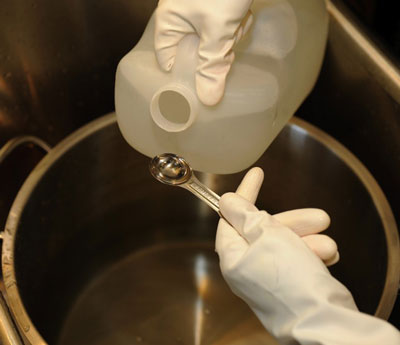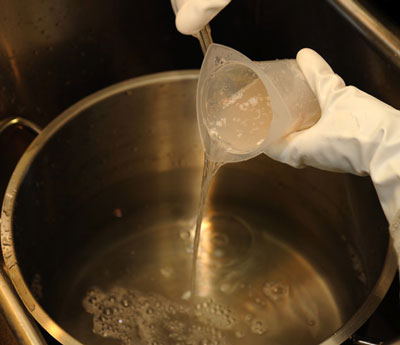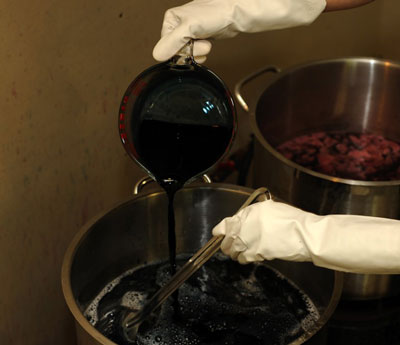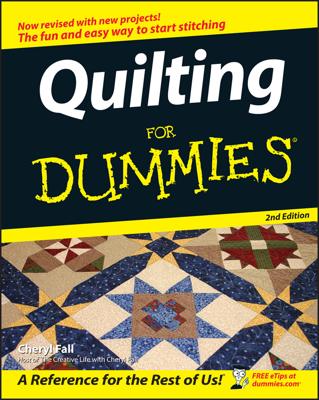Immersion dyeing is the process of creating a dye bath in a large pot, adding fiber and heating it. This method is used for dying fibers a solid color. Hand-dyed solids have rich tonal characteristics and subtle shading variations that set them apart from commercially dyed solid colors.
Determine how much dye stock to use.
Create 2 cups/500ml of a 1% dye stock by mixing 5 grams of dye powder with 500ml of boiling water. In general, 500ml of a 1% dye stock is enough to dye one pound of fiber a deep color.
If you need consistent, repeatable results use the metric system and this basic formula:
Weight of dye goods × depth of shade ÷ strength of dye stock = amount of dye stock needed
Here is the formula for dyeing one pound / 454g of yarn to a 1% depth of shade using a 1% dye stock:
454g × 1 (DOS) = 454
454 ÷ 1 (Strength of Dye Stock) = 454ml of 1% dye stock
Determine how much liquid to use.
As a rule of thumb, 3-1⁄2 gallons is a sufficient amount of water for dyeing one pound/454g of fiber.
The ratio of liquid (which includes dye stock and water) to fiber is approximately 30:1.
If using percentage dyeing for repeatable results, you would use a formula to calculate the volume of liquid using the metric system. Multiply the weight of dye goods times 30 to arrive at the total volume of liquid needed.
454g × 30 = 13,620ml total amount dye liquor needed
Remember to subtract the volume of dye stock (in this case 454ml) from the total to calculate the amount of water to add to the dye bath:
13, 620ml – 454 = 13,166ml (or 13.2 liters) total amount of water
Fill a 40-quart stainless steel stock pot (or an unchipped enamel pot of similar size) with 3-1⁄2 gallons room-temperature water. Add 1 teaspoon Synthrapol to the pot and stir.

13.2 liters is very close to the ball-park volume of 3-1/2 gallons liquid per pound of fiber.
Predissolve 1 tablespoon Glauber salt in 1⁄2 cup warm water, and then add it to the pot.
The salt tends to crystallize in water, so make sure it has fully dissolved.
Glauber salt serves as a leveling agent. It forms a temporary bond with the fiber, slowing and inhibiting the process of the dye molecules bonding with the fiber. This enables the dye to bond more evenly and helps achieve color uniformity. In general, 1 tablespoon of Glauber salt for each pound (454g) of fiber in the dye bath is sufficient.
Add 1 tablespoon citric acid crystals to the pot. Stir well so that the crystals dissolve completely.

Citric acid acts as a dye assist. It alters the pH of the dye bath (acid dyes work in the pH range of 4–6) and, along with heat, causes the dye molecules to bond with the fibers. White vinegar can be substituted for citric acid crystals. You typically use 1 tablespoon of citric acid crystals (or 11 tablespoons of white vinegar) per pound (454g) of fiber in the dye bath.
Add the dissolved dye solution to the pot and stir well.

Long-handled spoon, tongs or dowels are useful for manipulating the fiber in the dye bath.

